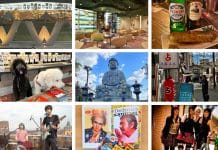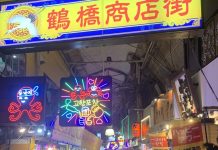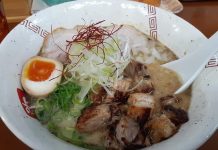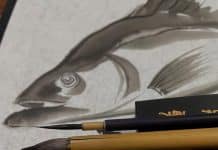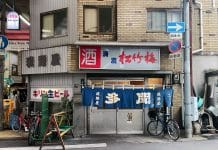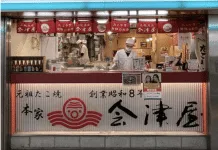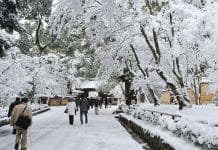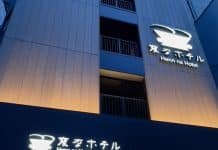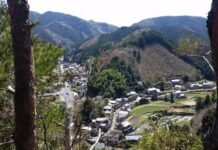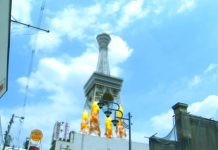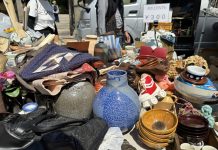Shitennoji Flea Market is held on the 21st and 22nd of every month from 8:30 until 16:30. Admission is free.
This month I got a chance to visit an Osaka staple: the Shitennoji Market at the 1000 year old + Shitennoji Temple in Osaka. It’s the biggest such marketplace in all of Kansai. I’ve only been to one other in Japan which was the Toji Temple Market in Kyoto but this was a totally different experience! Like Toji there were many Japanese antiques but also cute American retro items like Snoopy, Mr. Peanut and signs, etc.
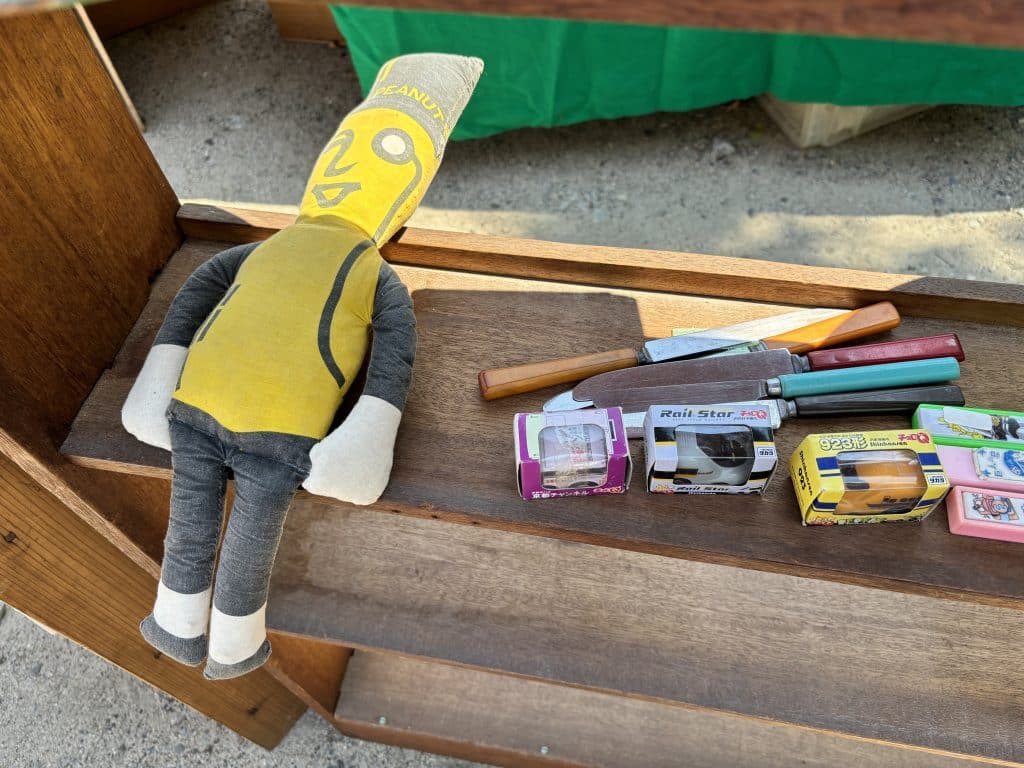
Table of Contents
Great for foreign visitors
As I started exploring Shitennoji I noticed many stalls didn’t have their prices listed (which usually means an expensive item.) However, I tend to prefer stores with a “100 yen” bin or “500 yen” bin. There’s no need to ask the cost and you can find treasure amidst the junk. It’s fun to search for something priceless when walking around a flea market. Sometimes the best stuff is deep in the back so it may take some digging. Some booths are very small so I had to crouch down to work my way inside.
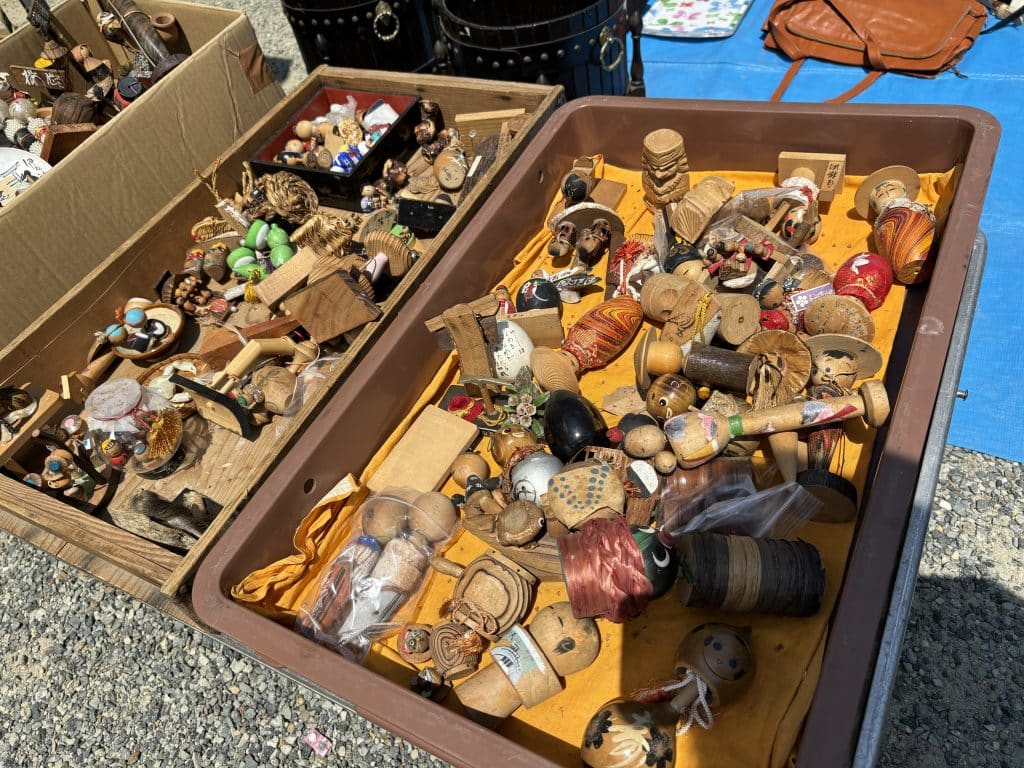
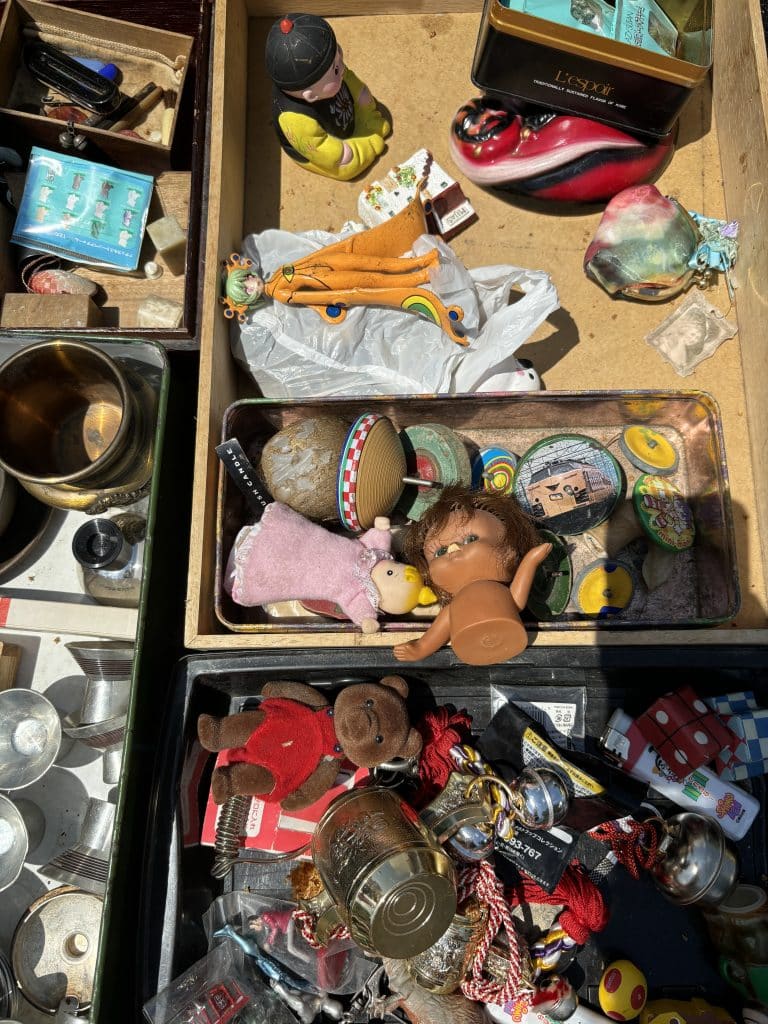

Some American friends came to visit Japan recently and joined me at the market. They bought “kashibon” which can be used as a cake tray dish. It’s also a type of “shikki” which translates as lacquerware which is a traditional craft in Japan. The different sizes determine the use. My pal bought one as a jewelry display -a creative use!
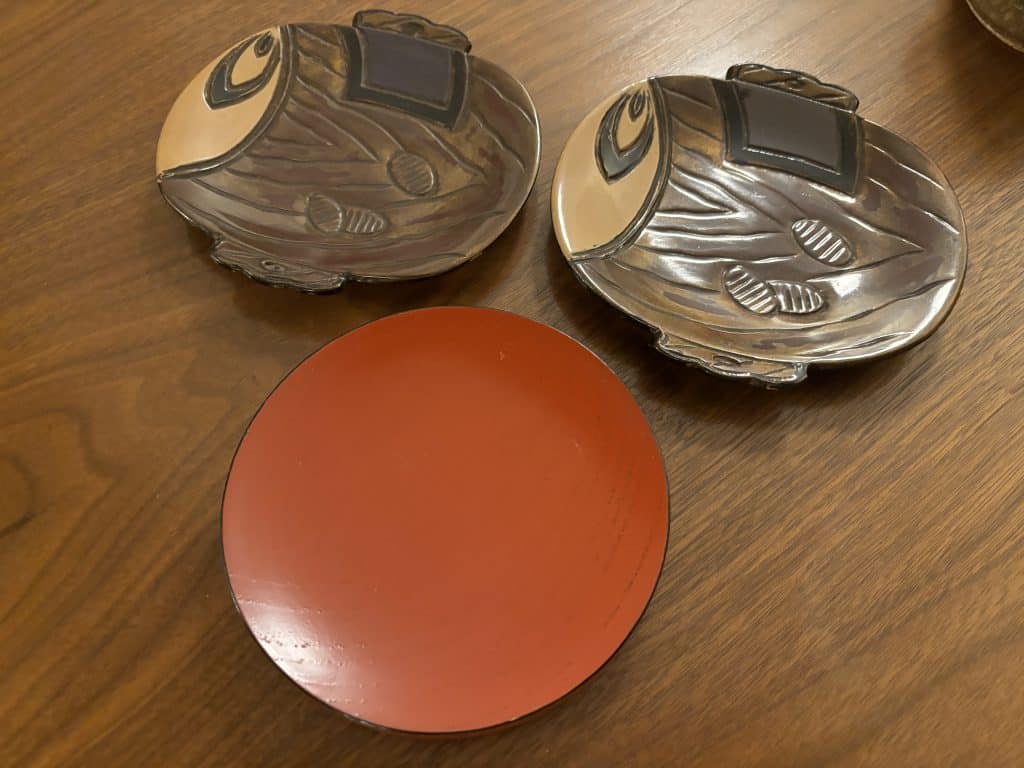
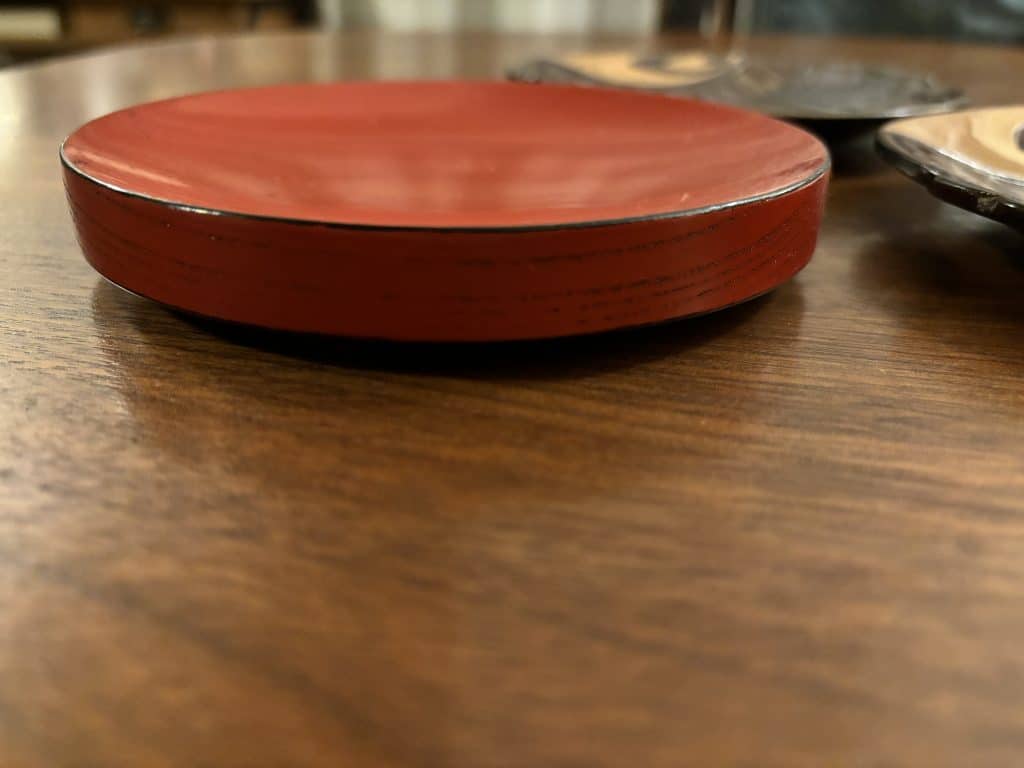
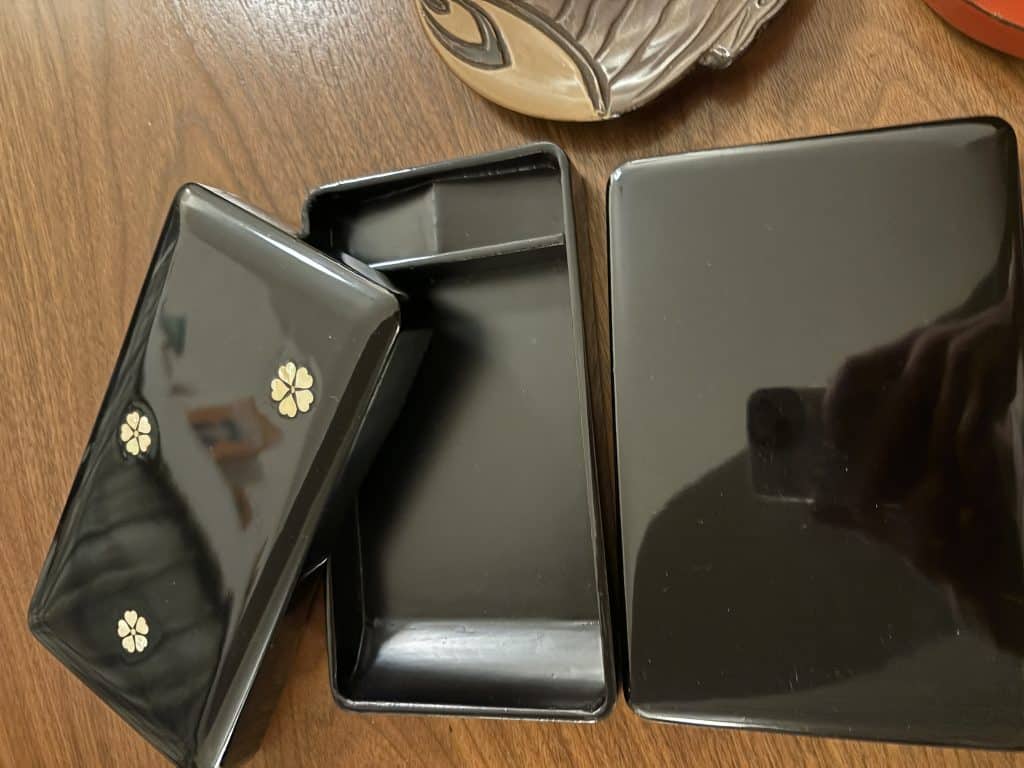
Learning to distinguish the good ones (which may be heavier, with a flower design, include an original box, etc) and the cheaper ones requires some practice. And of course you can try bargaining in Japanese by saying “makete” to see if the sellers go lower -it’s an Osaka tradition.
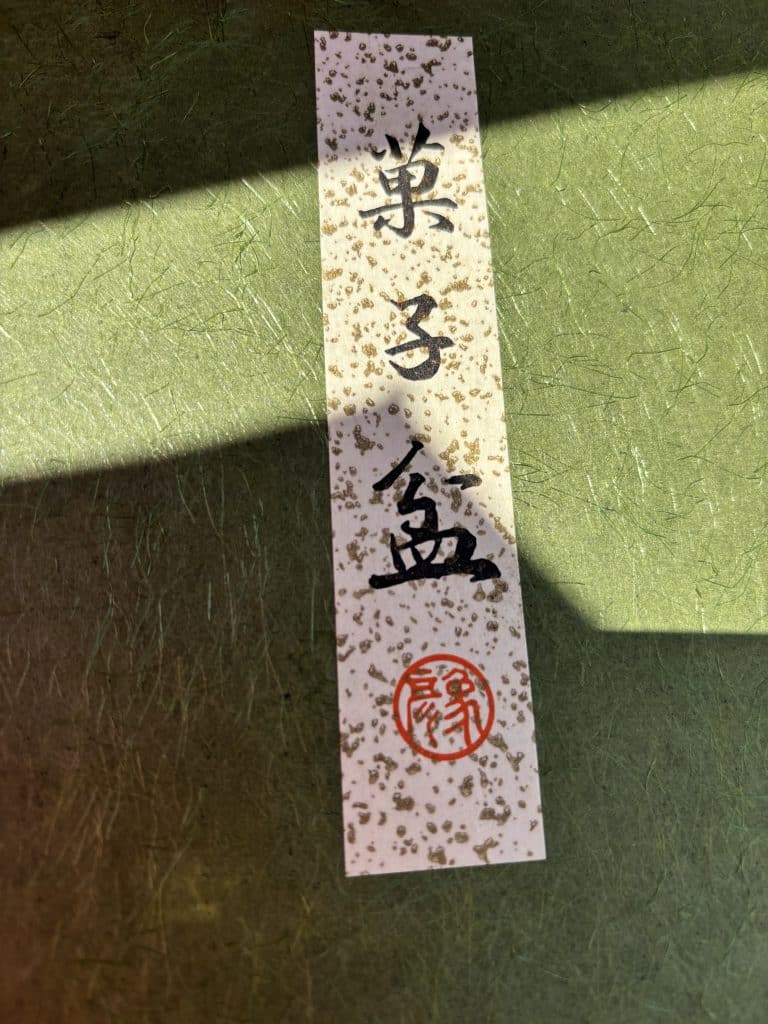
It was fun explaining the different Japanese items to the visitors. They found a used clothing stall and spent over 30 minutes there (partially because it was under a tent which offered shelter from the incredible heat.) Her boyfriend was laughing about the strange Japanese brand names in the 500 yen clothing rack which included “Pumpkin Port” and “Its.” But they were all made in Japan.
Finding fine quality domestically made clothing for 500 yen is a steal! Unheard of! If you go to Lucua department store in Umeda these start at least 10,000 yen! Not to mention a collection of colorful loud clothing with retro prints and fluorescent patterns couldn’t be found for $5 or less in America. (With the dollar to yen exchange ratio it’s more like $3.50.)
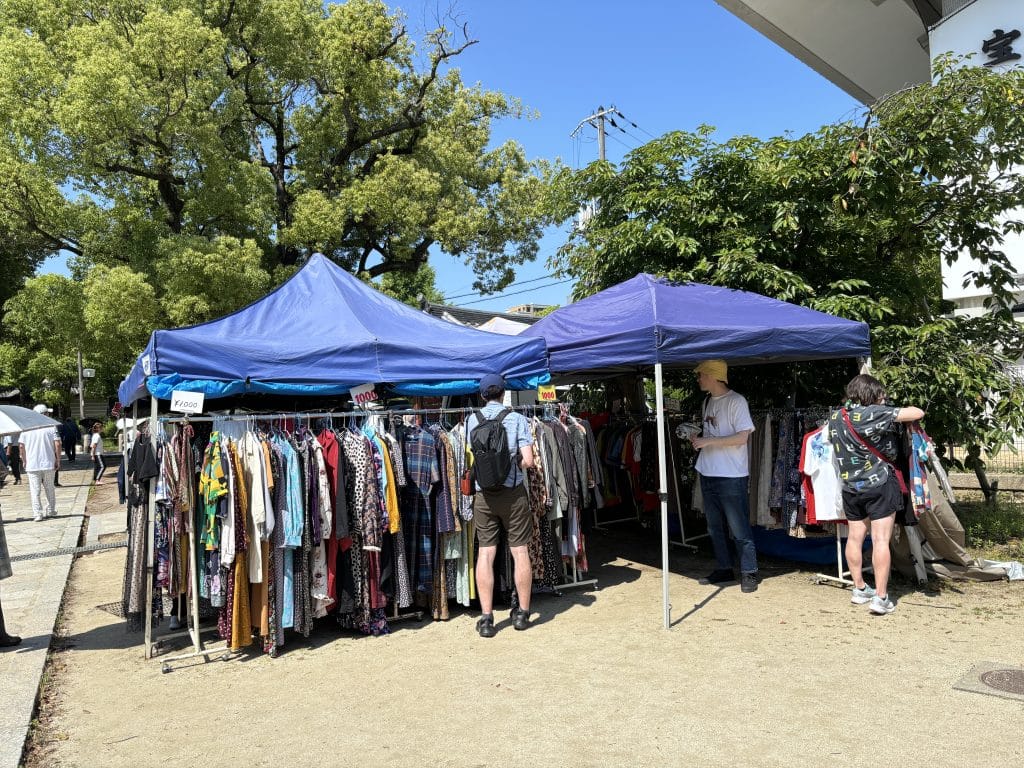
What to bring
The day we visited it was the end of May but it was still incredibly hot. We brought sun umbrellas but realized that while holding them it was hard to inspect the items in the market. I had bought tons of bagels at Osaka’s famous Happy Camper Bagel earlier so I was also clutching those! (They were too good to resist buying!) Hanging on to a bag of bread while trying to shop and hold the parasol in the heat was impossible. Our friends were also not used to the Japanese swelter and looked on the verge of sun stroke.

Next time I’ll have to remember to have light luggage -a shoulder bag, sunblock, and water should suffice. Starting in May you’ll want to block those sun rays and prepare for heat but the umbrella is going to get in the way because of all the people and you’ll need your hands for shopping. A shoulder bag will free them up. Also a pocket tissue or handkerchief will be good for wiping your sweat. I forgot to bring water as well although there was (only one?) vending machine. Our American friends were shocked that there was no soap in the toilet -so you may want to bring hand sanitizer too.
The bathrooms were located a short walk from the entrance where there were some stalls set up which brings me to another tip: don’t buy from the store closest to the front. These stalls tend to be more expensive and there may be cheaper prices further inside. At one of those I taught my American buddy to say “makete” on an 1800 yen shirt and the owner refused! But once we got further inside and found the 500 yen rack there was no reason to bargain, it was already cheap enough! The 1800 shirt was made in China but the 500 yen one was made in Japan… go figure!
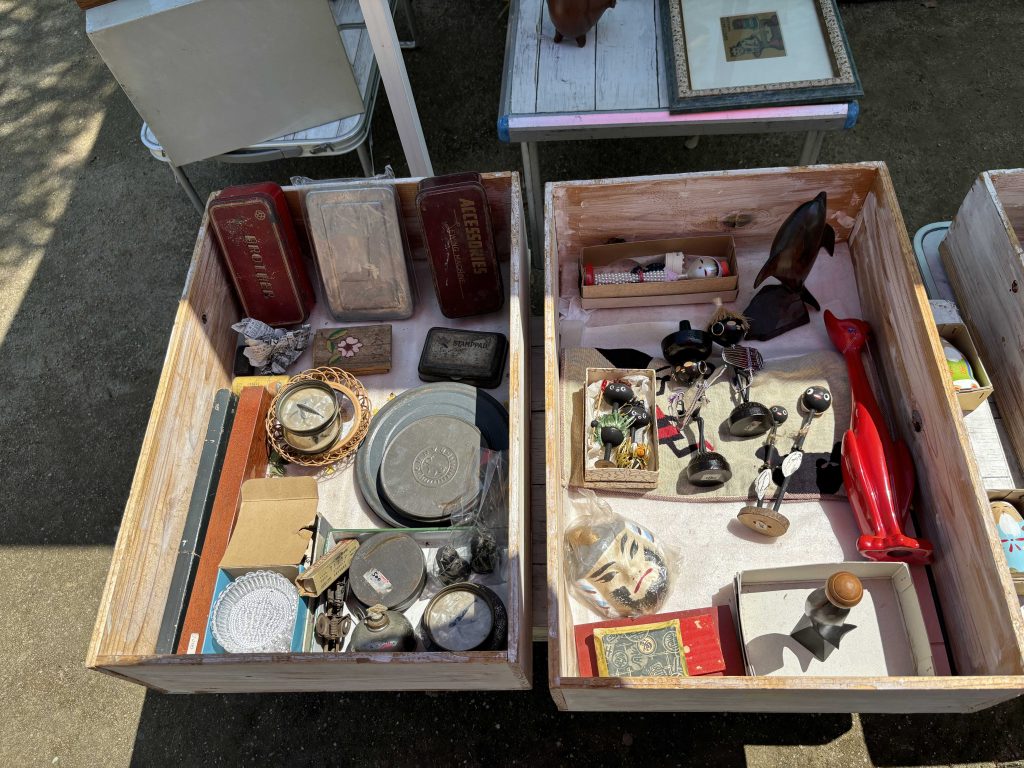
Different stalls, different aesthetics
You can get a sense of the aesthetic of each stall by gazing at the layout of the objects and types of things they sell. It’s fun to look at the differences between stores. Some people just dump out their junk into a bin and some like this one below take great care to display it like an open-air museum.
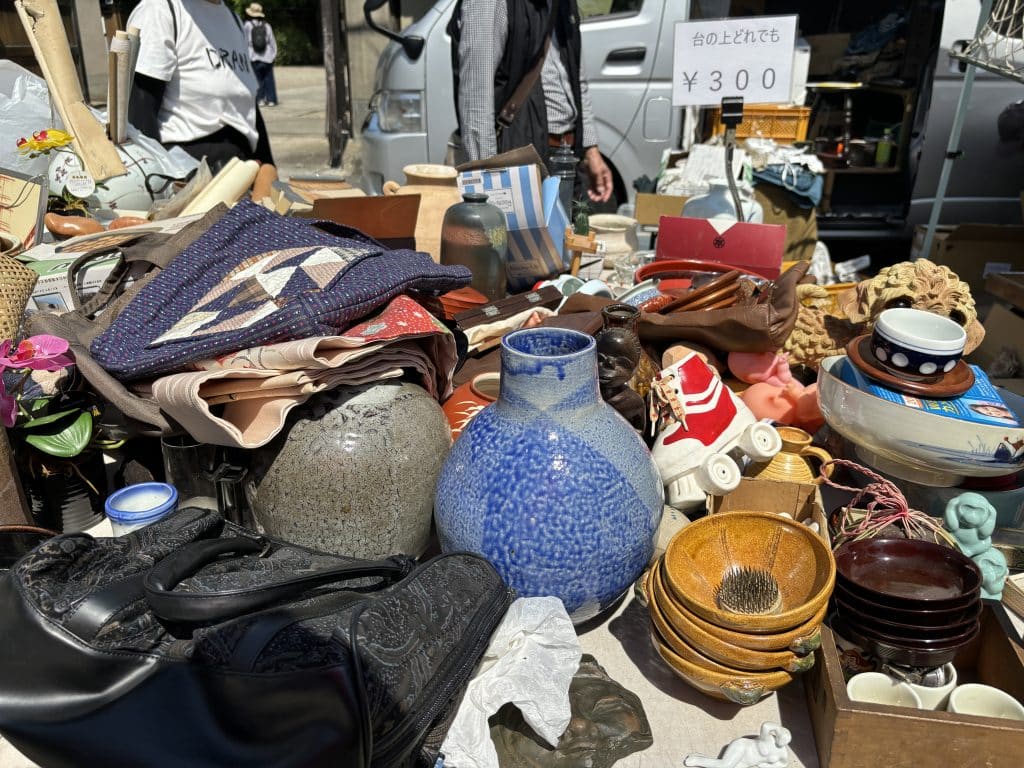
In this layout of “everything 300 yen” I was excited that perhaps an expensive treasure was inside. It was so incredibly hot and I had so many bagels (as I mentioned) that I couldn’t bring myself to get in there to search. But the next time I’m more prepared I may come away with something valuable.
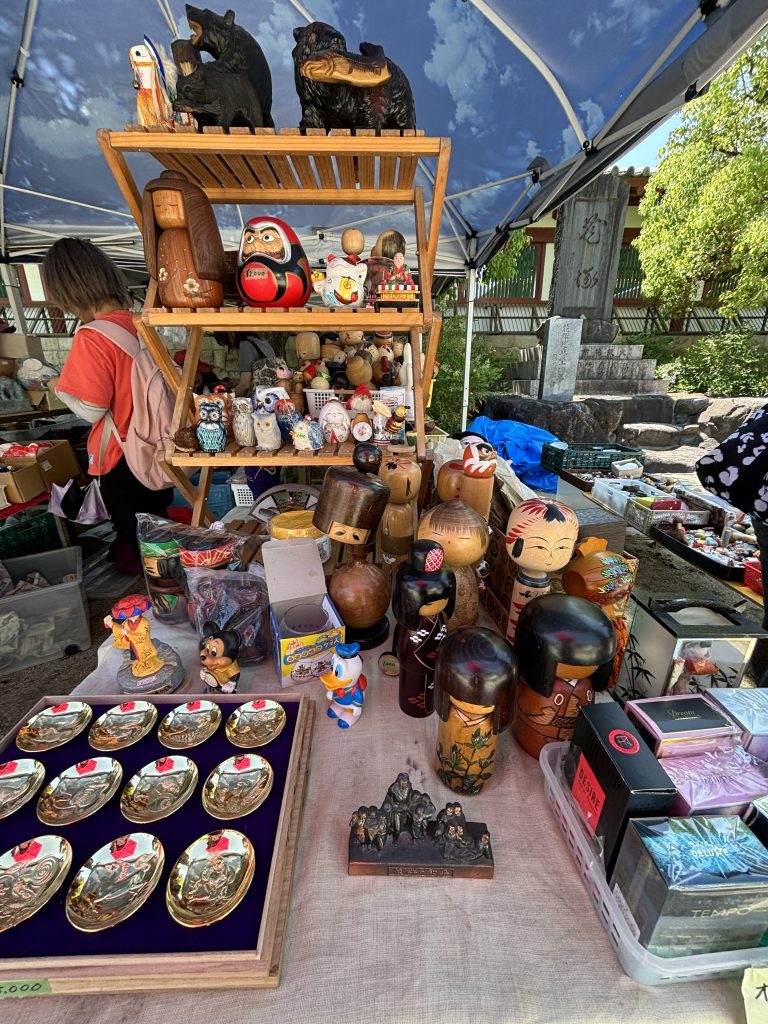
Even though I mentioned that I appreciate when they curate it like a museum (above) I prefer when they just dump everything out because it’s usually cheaper! I love the Donald Duck mixed in amongst the traditional Japanese objects! ↑
What kind of stuff
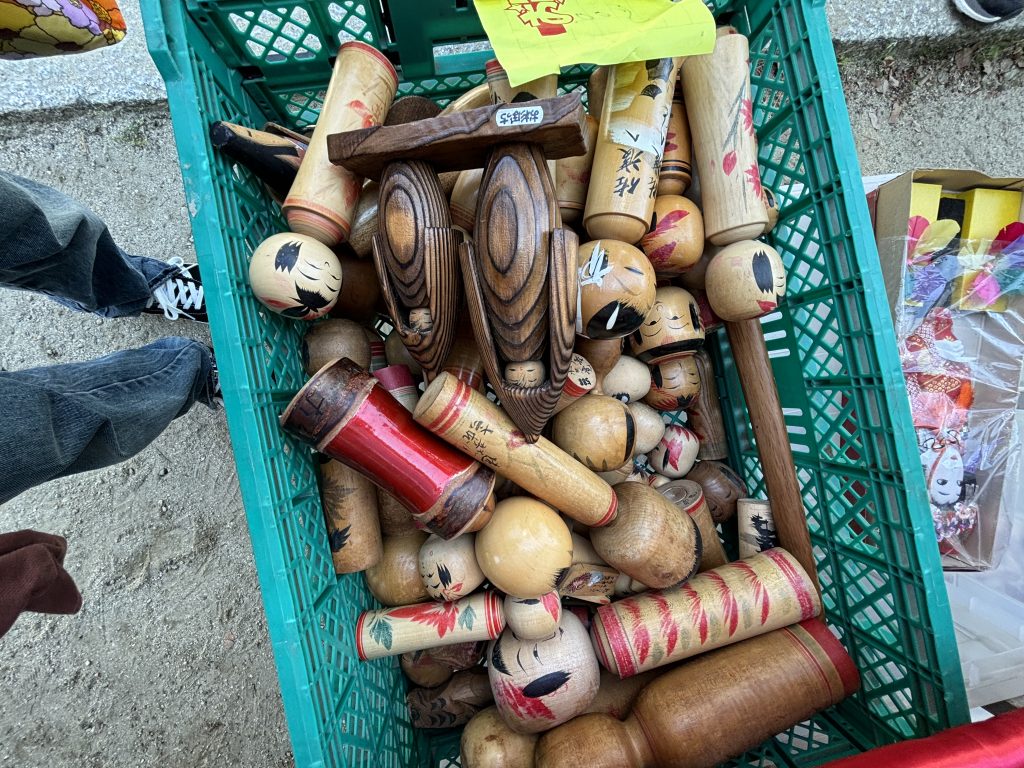
In the case of this seller as well, ↑ they just dumped a bunch of kokeshi into a crate. A kokeshi is a traditional wooden doll bought when a young girl is born in Japanese households. Every region of Japan has a different design. Maybe this bin has some unusual types hidden below?
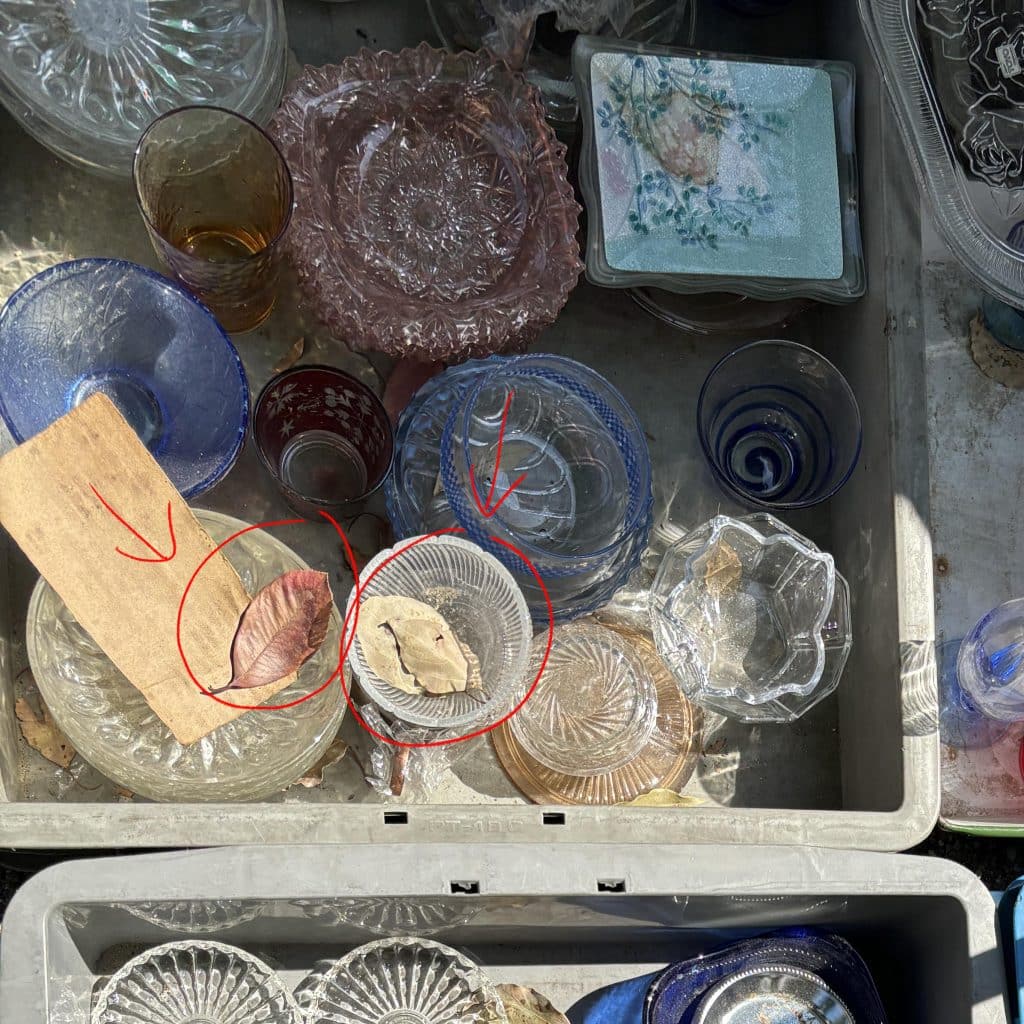
While digging through the dolls I overheard a seller say “I don’t make any profit doing this!” I wondered what brought him here. Perhaps he’s doing it for fun or to get rid of his junk. I was laughing at the fallen leaves in the beautiful glass too (it gave it a retro feel!)
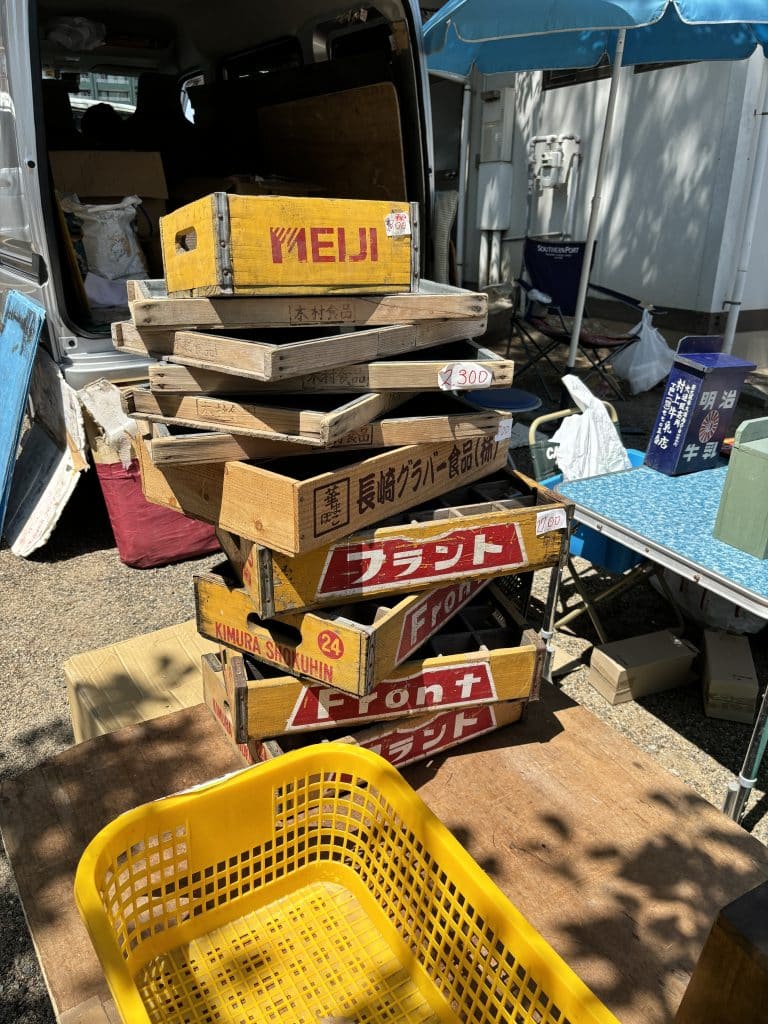
Close by I stumbled upon some more interesting stuff. I’ve always been a fan of these bottle crates which are usually plastic. But these older Meiji milk wooden ones were fascinating to see in person. They’re not cheap though! And speaking of milk…
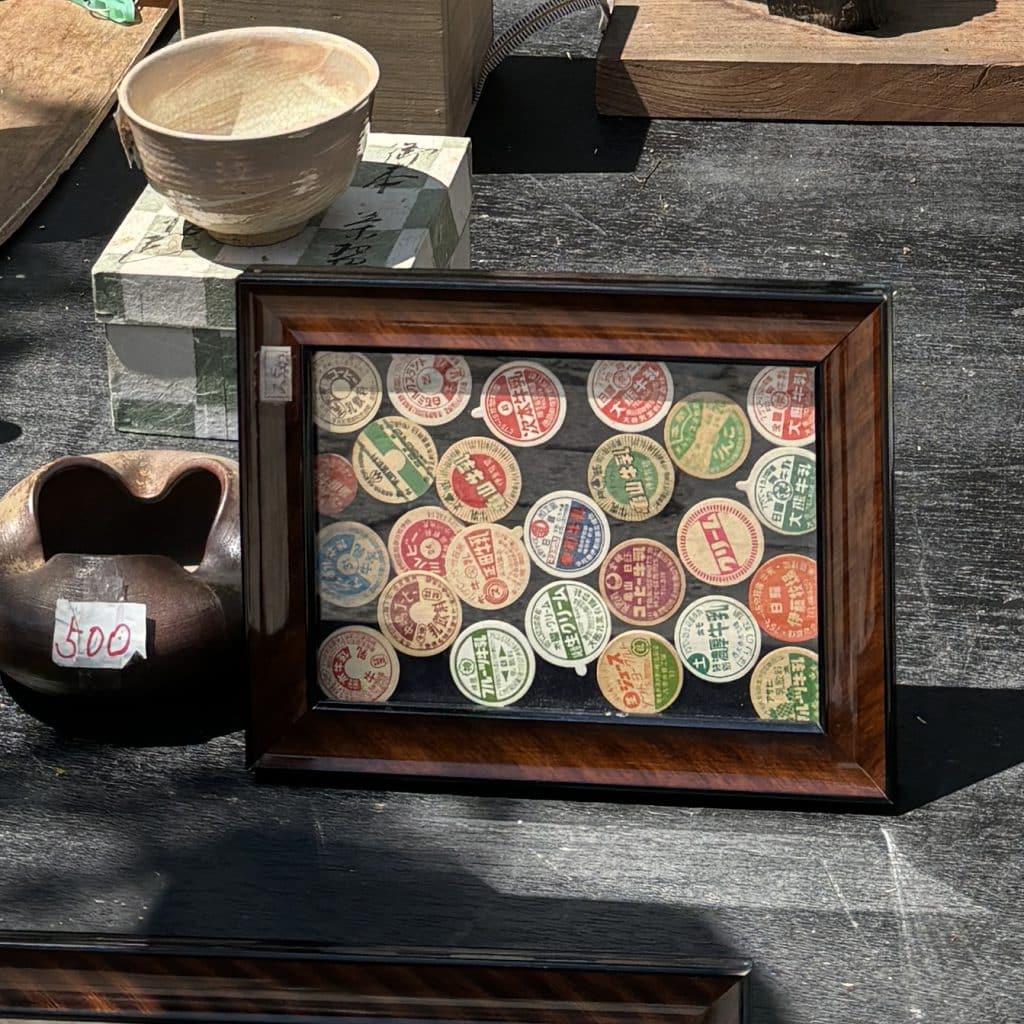
I was happy to see these nostalgic milk bottle tops. When I was younger these were the seal to glass bottles that we drank from in school. I recollected the phrase “one man’s trash is another man’s treasure.” How true! We tossed these so many years ago I’m glad this fellow hung on to them! It’s wonderful to see them again and reflect upon my school days!
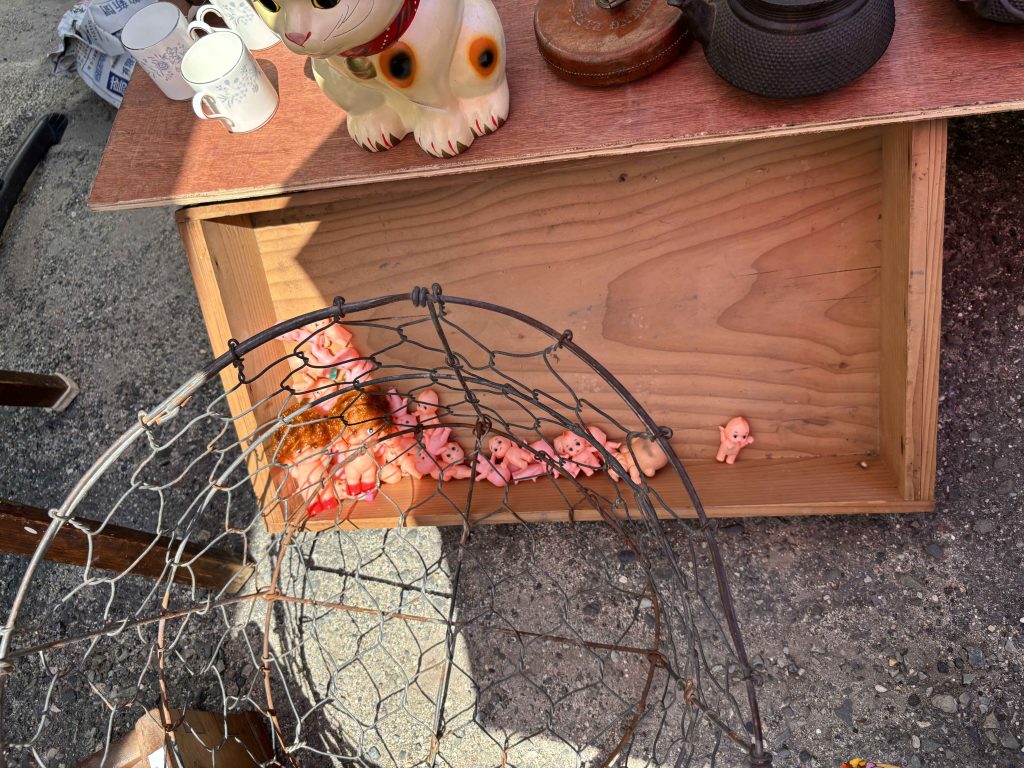
There are also little surreal scenes like this ↑ which are fun to search for around the stalls. I wondered to myself “why are little Kewpie babies in this wooden box?” I love that one of them is lonely and left out too! It creates a sad story! And why are they under this odd chicken wire? It raises so many questions. Even if you’re not buying anything you can come to the Shitennoji Flea market for these hidden forms of entertainment all around. Perhaps this owner had an ironic sense of humor, who knows?
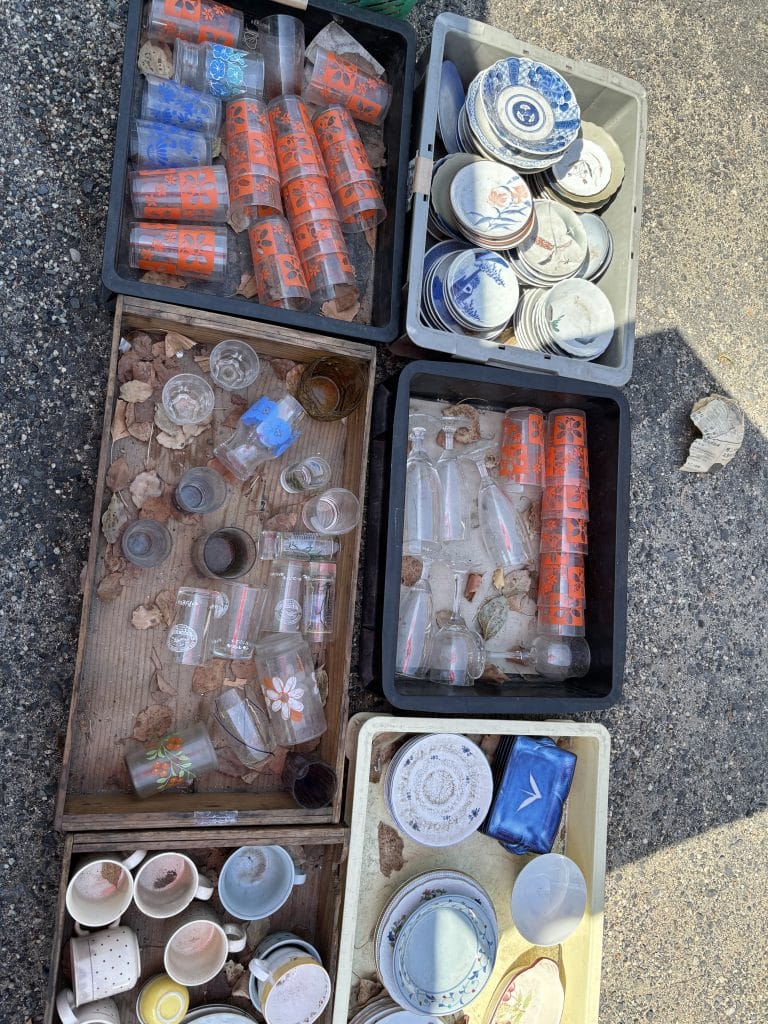
Cups and plates, traditional ceramics and crafts
↑ This store of glass cups and plates didn’t pop out to me comedically, but I loved the colorful collections that differed from some of the more traditional ceramics. These cute retro glasses stuck out. But I did have to laugh again at the fallen leaves mixed with the cups! My pet theory was the stores with the dirt and leaves tend to be cheaper!
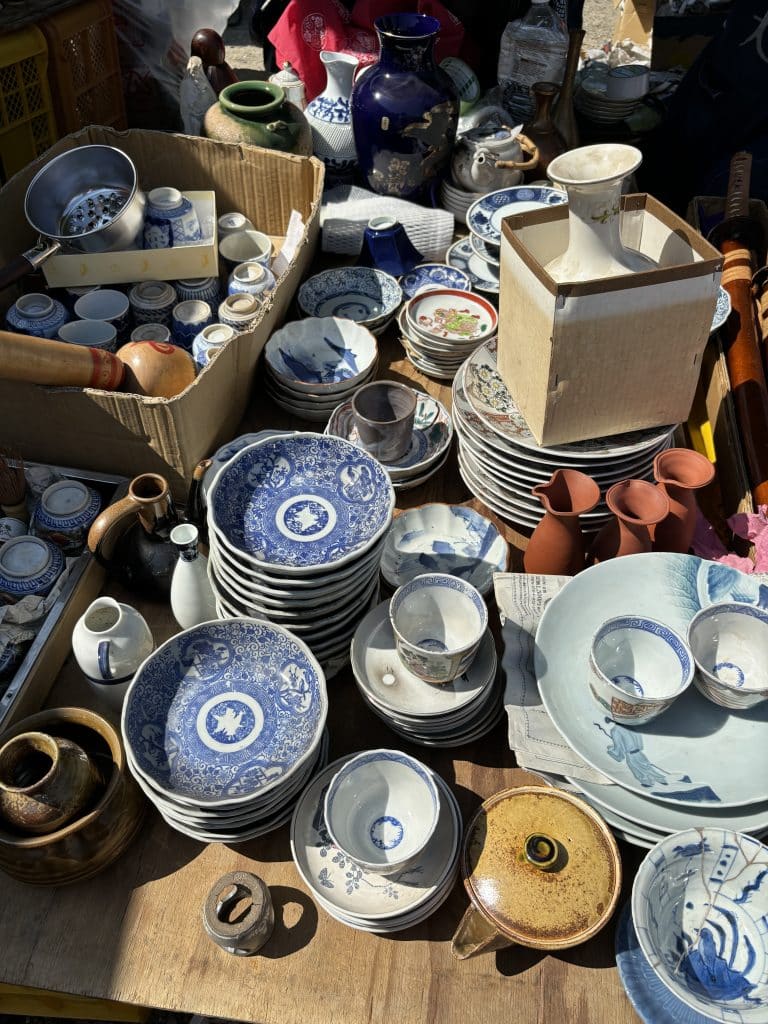
Nearby I found some Japanese ceramics that looked potentially valuable. I have studied hard to identify these because there are many varieties in Japan. These include: Bizenyaki, Mashikoyaki, (Ko)imariyaki, etc. Koimariyaki is colorful and popular with Japanese and foreigners alike -and most importantly: it’s very expensive! My 95 year old grandmother taught me about it and she had quite the collection herself reserved for when she had important guests! Here are a few from her collection:
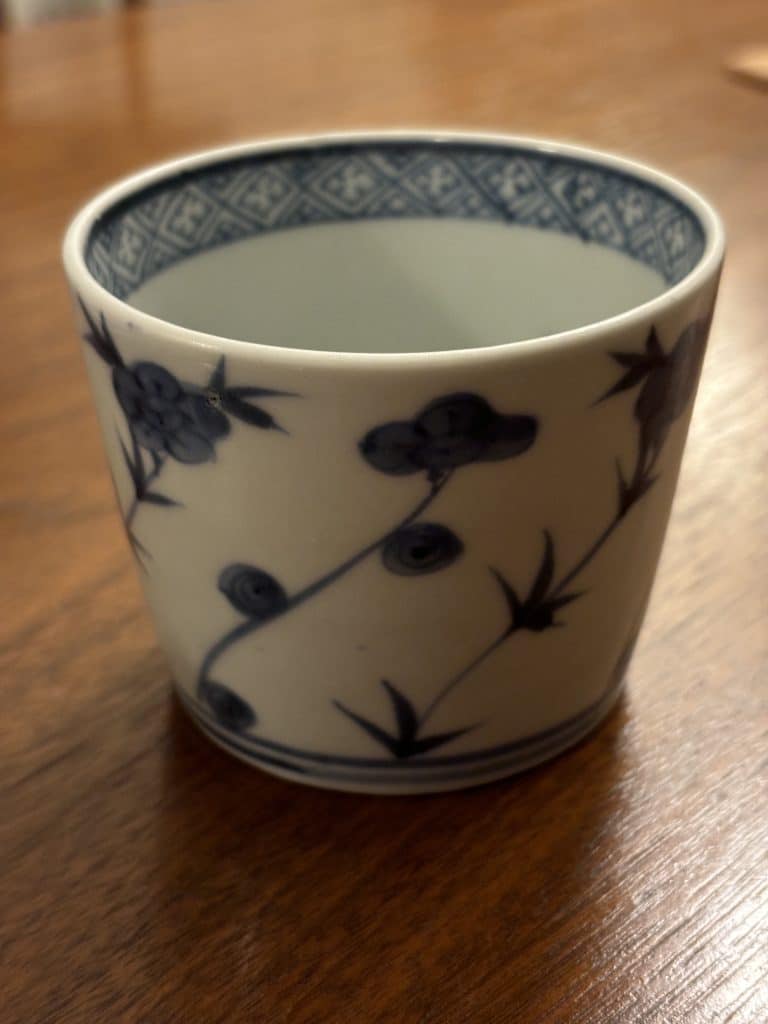
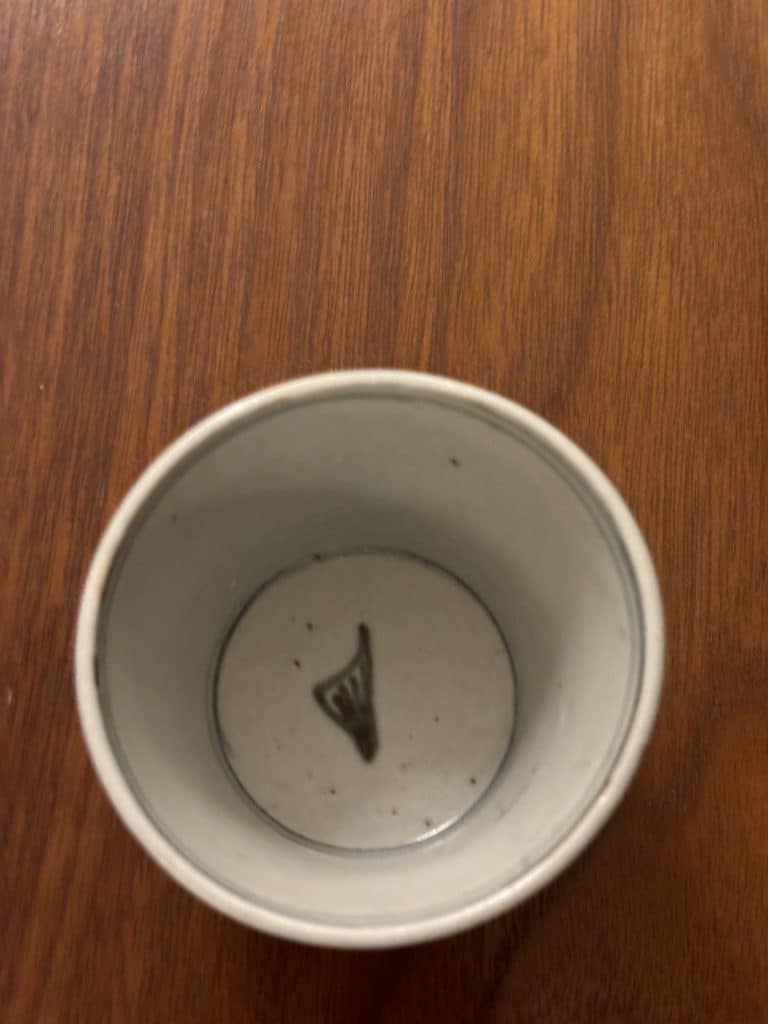

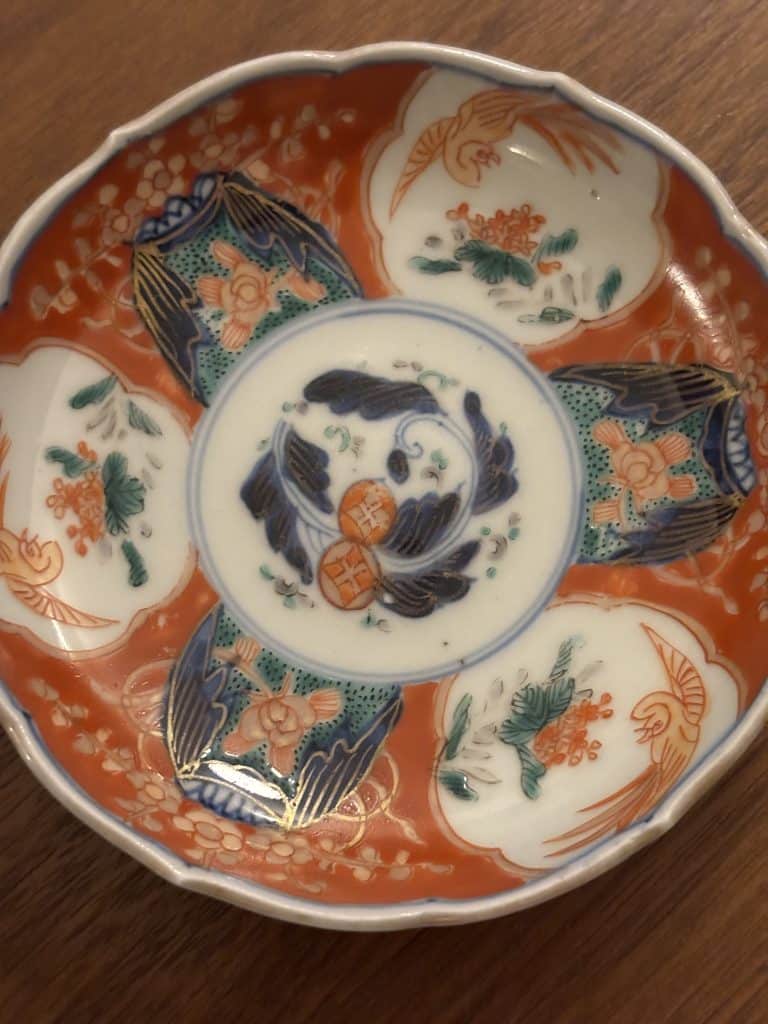
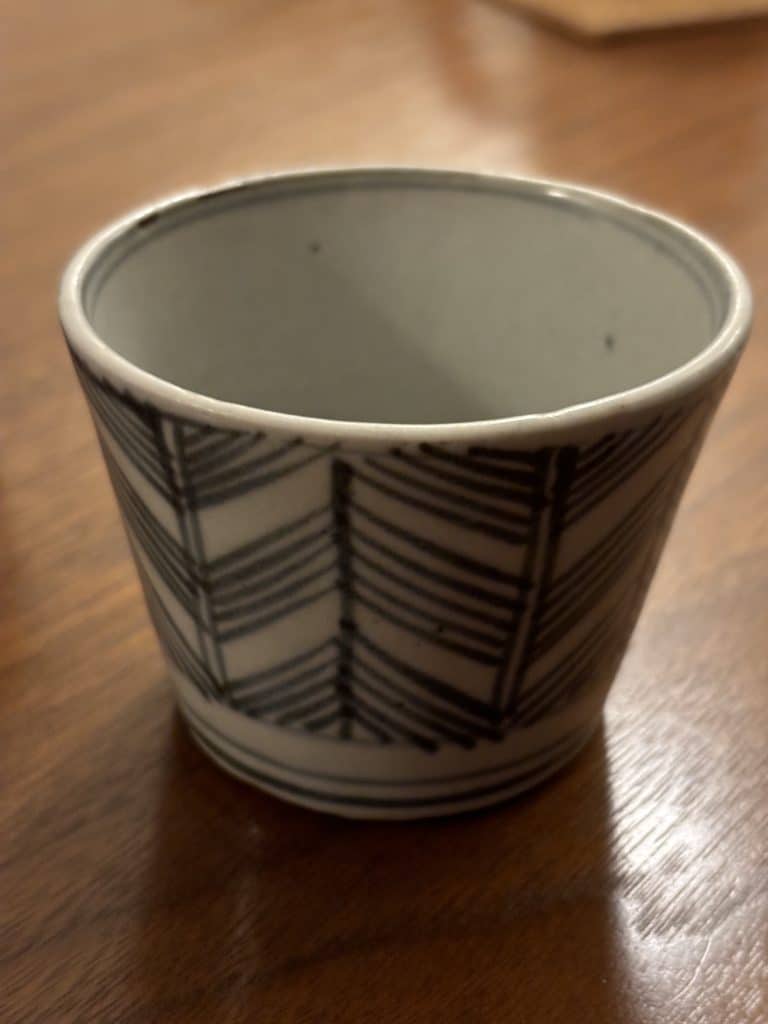
These are worth much more than the ones pictured below (from the flea market.) Can you tell the difference?
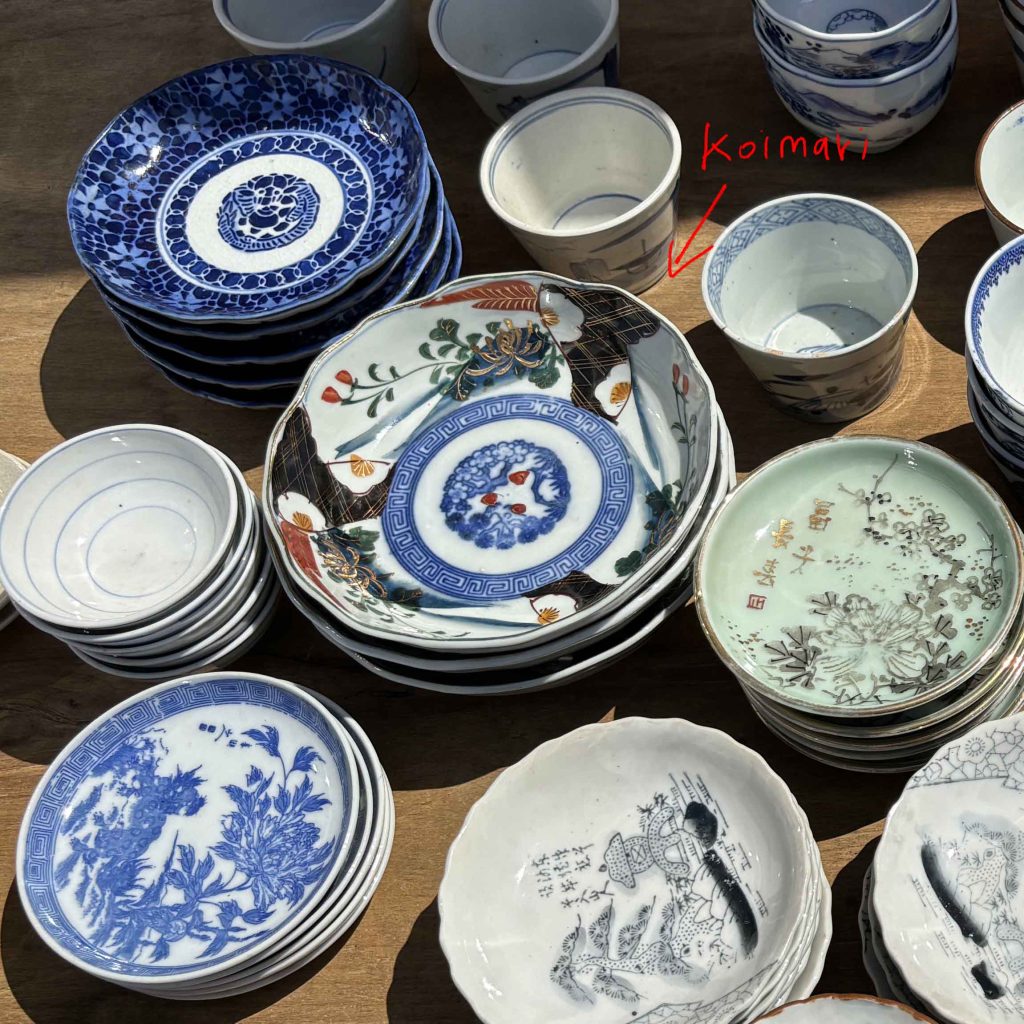
The (ko) in koimari means “old” (which may explain the higher price.) They even sell books for identifying Komari (almost like mushroom hunting guidebooks!) It’s a wide world of Japanese ceramics, and the more you study the better your chances of finding a treasure!
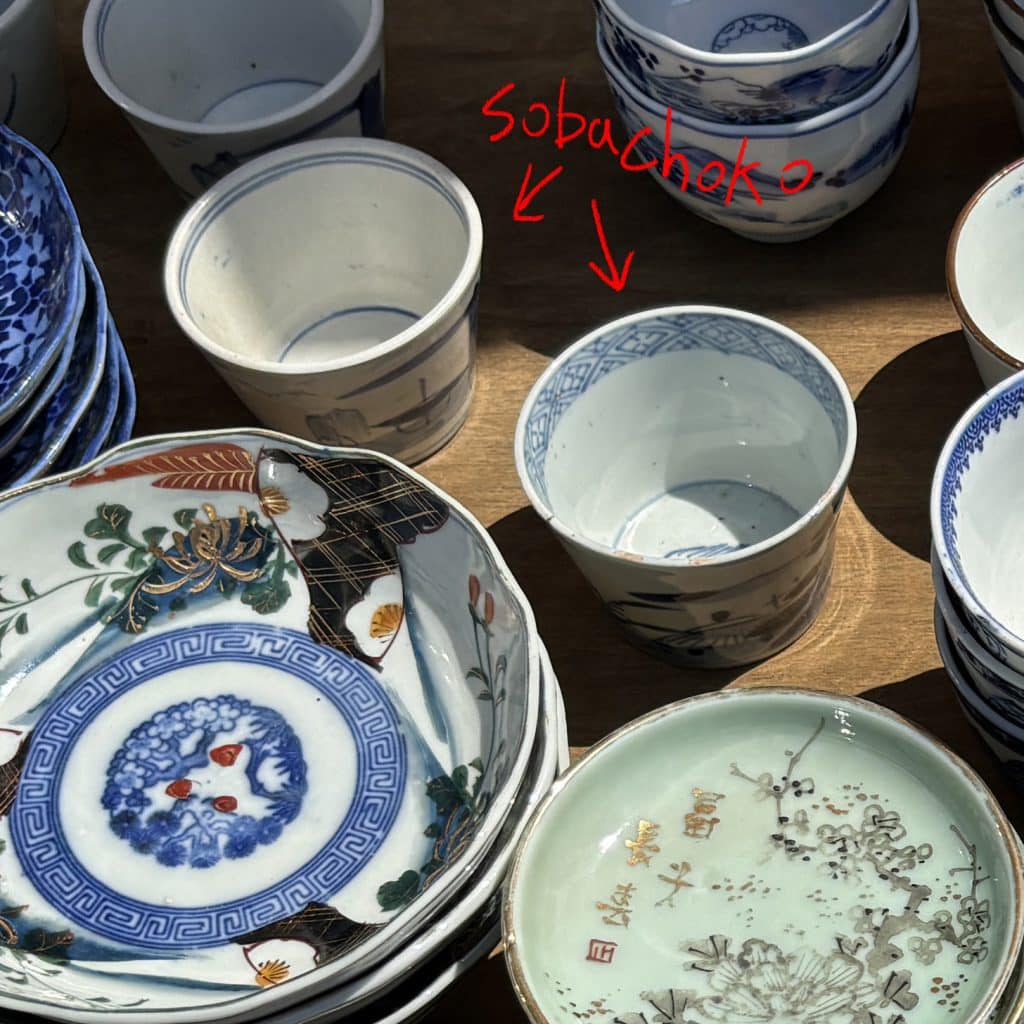
Another ceramic type my grandmother taught me about was “sobachoko.” These are for dipping soba in the tsuyu. I figured these small cups were cheap but they were over 4000 yen! They must be Koimari to be listed at such a high price, or perhaps another type called Aritayaki. (This is why it’s so important to study beforehand!)
Others..

These cookie-cutters also caught my attention. I have seen these at cooking speciality shops and 100 yen shops. The baking stores are too expensive and the 100 yen types are junk that will break in a week! These may be old but they’re good quality and many of them are made in Japan. The best thing is they’re cheap cheap cheap! Dumped in a box like this you know you’ll find a deal! Don’t be a sucker and buy it new for full price!

And when walking between stalls there was a little lake I gazed across and saw some interesting stone turtle sculptures that looked incredibly realistic. But upon closer look…

They weren’t sculptures at all. They were living and breathing and enjoying the sun (more than I was!) This was another humorous incident that day (Osaka is known for its comedy.) I was trying to find the turtle sign that said “not for sale.”
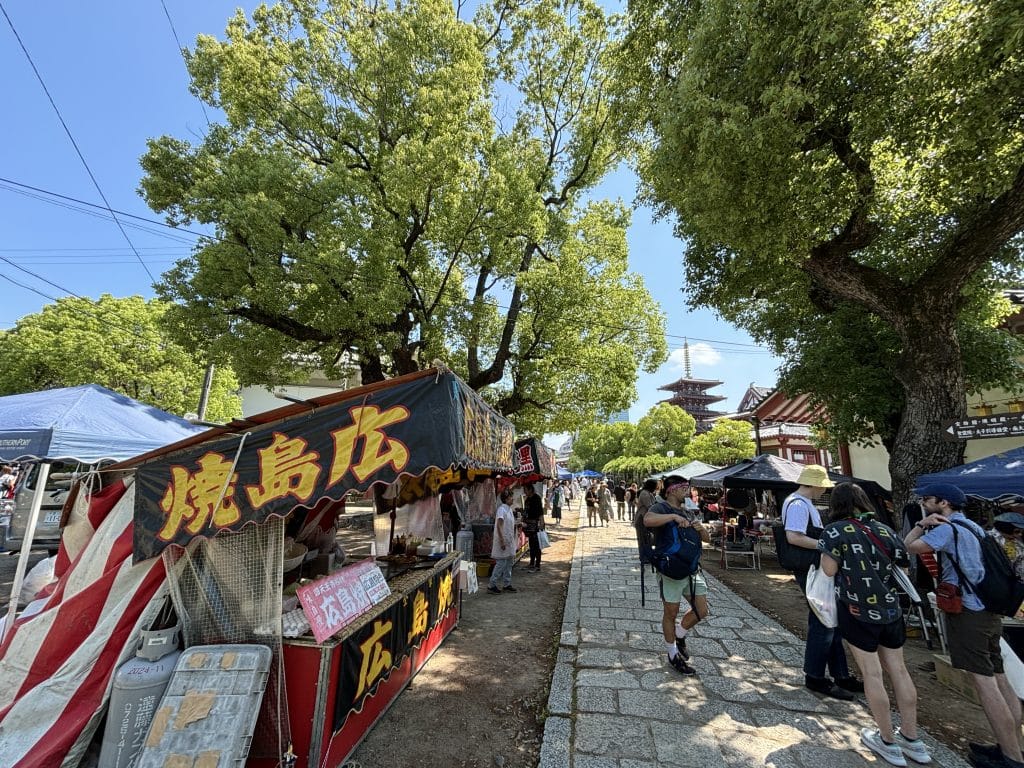
And it’s not just objects they sell. Here you can see a stall selling “hiroshimayaki” which is a Hiroshima-style okonomiyaki on top of noodles. This street food can be fun to munch on and recharge when taking a break from shopping! Nearby were also dried fruits, nuts, and trail mix for sale too!

And last but not least before leaving the flea market I have to mention the traditional paper mache items. They’re usually sold on New Years at Japanese shrines. They are called “hariko” (when they are paper mace) or “engimono.” You can get them for cheap and many of them represent animals from the Chinese calendar. But Japanese believe that they may have the “spirit” of someone left over in them and need to be “exorcised” (perhaps with some salt or a buddhist prayer?) Make sure to check these out before walking out the door.
Suriganeya: bell-shaped manju
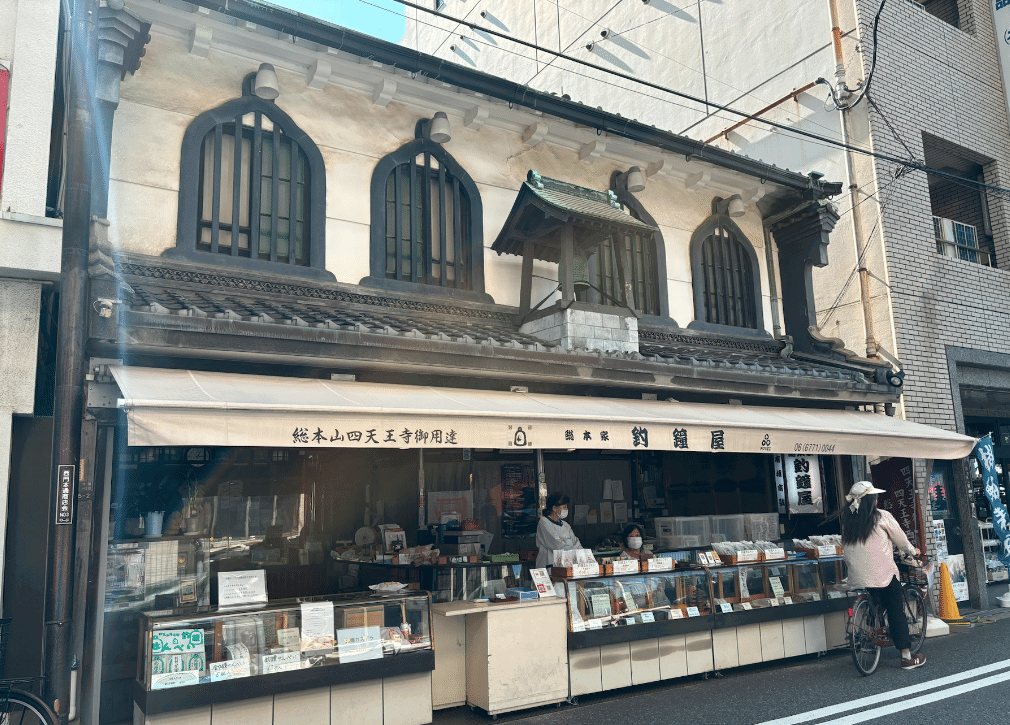
Once we left the temple we found an old manju store from over 120 years ago: Suriganeya. My grandma had been buying these for years but I had never been to the original store!
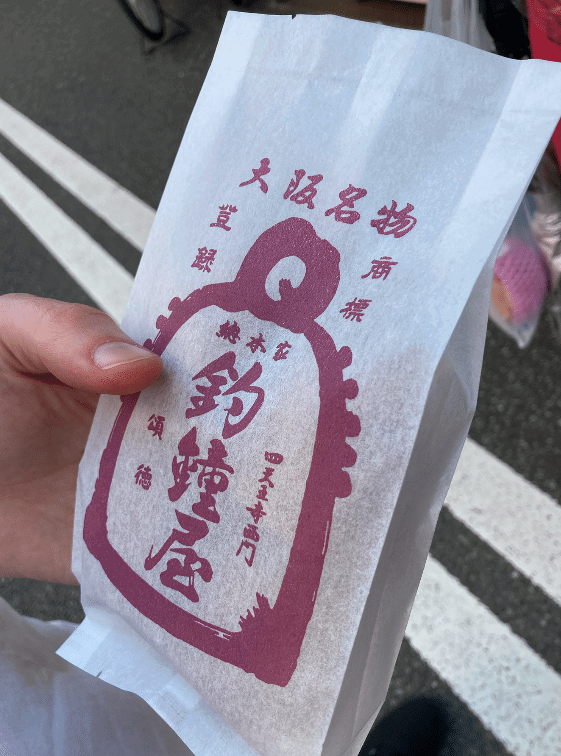
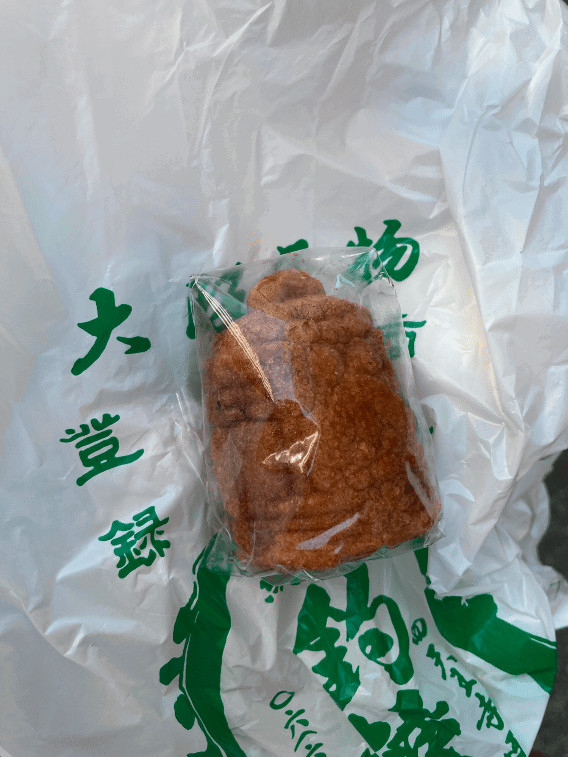
I happened to stumble across it as I was walking along the avenue outside Shitennoji. Manju is a moist wheat/egg outer layer covering a sweet bean filling. In this case it comes in the shape of a bell which is the same one you can see in that little “shack” on the top of the roof. Our visitors were not necessarily a fan of the red-bean flavor under normal circumstances but they loved this! Not to mention it came served piping hot. This place is an Osaka staple and shouldn’t be missed!
Retro Kissa

We were exhausted from our long day of walking around the flea market so we were searching around for a place to relax. We came upon a retro “kissa” (coffee cafe) not far from Suriganeya: Kissa Matoba. They had a fantastic retro interior and great menu. That day I ordered pancakes and toast. It was just what I needed to get my energy back from the long day!
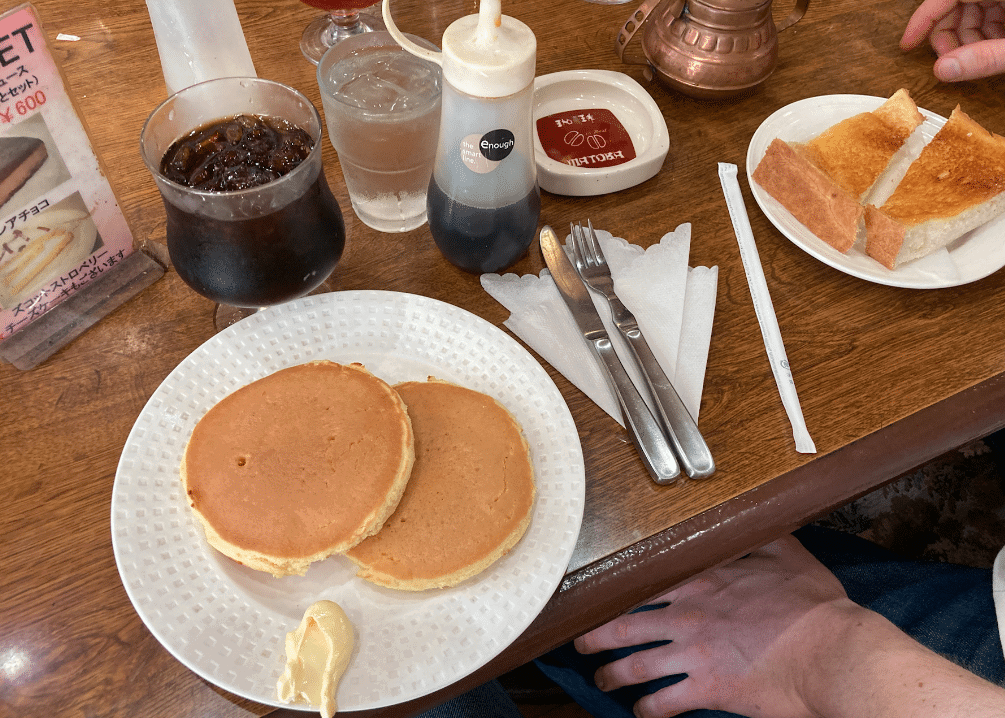
Unfortunately most of these retro coffee shops allow smoking, but when we got there nobody was inside so we figured it wouldn’t be a problem. But soon after our food came we had 3 people puffing all around us so we asked to move upstairs. We brought our plates to the 2nd floor and were pleasantly surprised to see we had the whole floor all to ourselves. There were big retro sofas and a long party table. We could stretch out and have a private conversation while enjoying our meal in this vintage interior. (We can thank the smokers for chasing us away to the nicer room!)
Every goodbye is a beginning
I enjoyed the flea market and as it starts to get hotter in Osaka I may have to avoid it until October when it’s cool again (That or come really early in the day before it warms up!) The great thing about Shitenoji Flea Market is that every time you go there’ll be something different -there’s always a surprise waiting in store! In the meantime I can read up on all the traditional crafts to make sure I find the best one!
Until next time!



